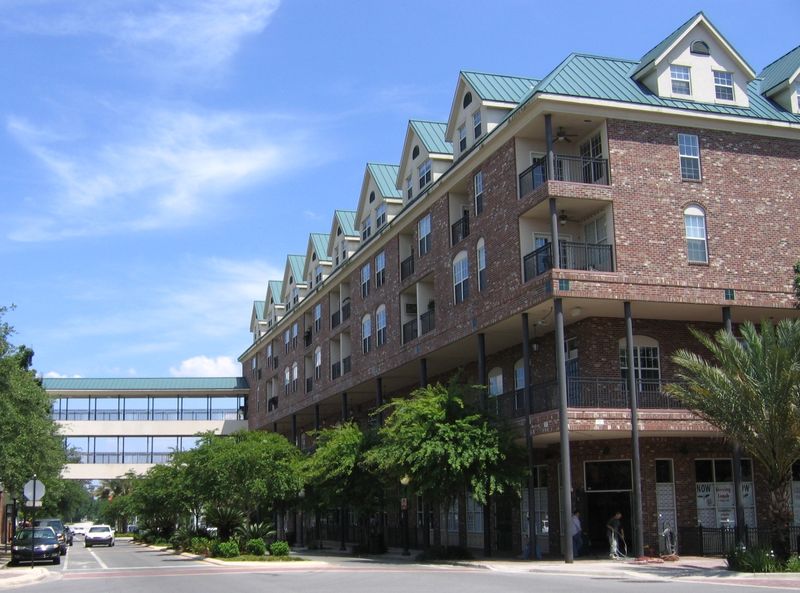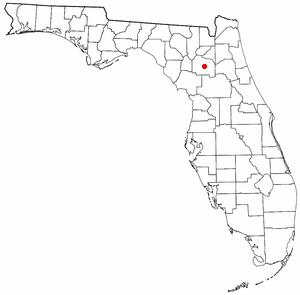About Gainesville
Gainesville is the largest city and county
seat of Alachua County, Florida.GR6. Gainesville
is primarily known for being home to the
University of Florida, the flagship university
of the State University System of Florida
and the fourth-largest university in the
United States. Santa Fe Community College,
one of the nation's largest community colleges,
is also located in Gainesville.
The 2000 Census reported the population
of Gainesville to be 95,447. Following a
successful annexation in 2002, the U.S.
Census Bureau estimated a 2004 |

Razor Gator |
| population of 108,856. However, the City
of Gainesville estimates the 2003 population
at 117,182. The Gainesville Metropolitan Statistical
Area (MSA), which includes Alachua and Gilchrist
counties, has a population of 239,114 as of
2005 Census Bureau estimates. |
 Downtown Gainesville
Downtown Gainesville |
Geography
Gainesville is the southernmost city
in the United States where deciduous trees predominate.
There are deciduous trees farther south, but they
are not as abundant as they are from Alachua County
northward. The city is also an important way station
for automobile travelers, as it is located nearly
midway between Atlanta and Miami, five hours from
Miami, and five from Atlanta.

Location of Gainesville, Florida
|
The North Florida area in which Gainesville
is located is known to natives as the "end
of the South." This is most likely due
to the fact that south of Alachua County or
Marion County, starting somewhere north of
Orlando, there are fewer native Floridians
(and effectively native Southerners) and the
sprawling development that defines South and
Central Florida begins. However, it should
be noted that due to large levels of migration,
much of it related to the University of Florida,
the western sector of the city as well as
areas around the university hold more in common
culturally and visually with Central and Southern
Florida, whereas the eastern sector of the
city holds more in common culturally and visually
with the South. |
The North Florida area in which Gainesville is
located is known to natives as the "end of
the South." This is most likely due to the
fact that south of Alachua County or Marion County,
starting somewhere north of Orlando, there are
fewer native Floridians (and effectively native
Southerners) and the sprawling development that
defines South and Central Florida begins. However,
it should be noted that due to large levels of
migration, much of it related to the University
of Florida, the western sector of the city as
well as areas around the university hold more
in common culturally and visually with Central
and Southern Florida, whereas the eastern sector
of the city holds more in common culturally and
visually with the South.
According to the United States Census Bureau,
the city has a total area of 127.2 km² (49.1
mi²). 124.8 km² (48.2 mi²) of it
is land and 2.4 km² (0.9 mi²) of it
is water. The total area is 1.87% water.
History
Gainesville's original inhabitants were the Timucua
Indians. Spanish colonists began cattle ranching
in the Payne's Prairie area using Timucua labor
and the largest ranch became known as LaChua.
Though the ranch was eventually destroyed by British
raiders, it nevertheless gave its name to the
Alachua band of the Seminole tribe who settled
in the region in the 1700s under the leadership
of the great chief Ahaya the Cowkeeper.
Gainesville was originally formed along the Florida
Railroad Company's line stretching from Cedar
Key to Fernandina Beach as part of a route eventually
carrying cargo from New Orleans to New York. In
1854 Gainesville became the new Alachua County
seat (moving from the more populated but inconveniently
located Newnansville). The city is named for General
Edmund P. Gaines, commander of U.S. Army troops
in Florida during the Second Seminole War.
Gainesville was the scene of small-scale fighting
in the Civil War. On February 15, 1864, a skirmish
erupted when about 50 Union troops entered the
city intending to capture two trains. The Second
Florida Cavalry successfully repulsed this raid.
The raiding party was eventually defeated at the
Battle of Olustee five days later. Later that
year, the Battle of Gainesville took place on
August 17, 1864. Three-hundred Union troops occupying
the city were attacked by the Florida Cavalry.
The Federals were driven out of town and suffered
significant casualties.
Following the civil war, the city prospered as
a major citrus growing center, with direct rail
access to ports on the Atlantic and Gulf of Mexico.
However, this prosperity ended when the great
freezes of 1894 and 1899 destroyed the entire
crops, and citrus growing moved permanently south
to the Orlando area. Other attempts to replace
this lost industry included phosphate mining,
turpentine production and tung oil had only moderate
success.
Gainesville's fortunes took a major turn for
the better, however, when the University
of Florida was created by the Florida Legislature
in 1905. Gainesville was chosen, beating out other
cities who saw their colleges close, such as Lake
City and Bartow. Fortunately, the city had the
foresight to construct a modern municipal water,
sewer and electric system and was able to offer
these services to a new university location for
free. A site was selected at a location then considered
about a mile west of town. The first classes were
held at Buckman Hall in the fall of 1906.
Over the past century, the university has brought
the town a youthful population, cultural opportunities,
and world class medical facilities. The sports
drink Gatorade was invented in Gainesville as
a means of refreshing the UF football team and
UF still receives a share of the profits from
the beverage.
Culture
Gainesville has a fairly well-known punk and ska
music scene and has spawned a number of bands
including Tom Petty and the Heartbreakers, Less
Than Jake, The Usuals, The Know How, Hot Water
Music, Against Me!, Sister Hazel, Roach Motel,
and For Squirrels. It is also the location of
the independent label No Idea Records and the
annual underground rock festival known as The
Fest, which is co-operated by No Idea.
Cultural facilities include the Florida Museum
of Natural History, Harn Museum of Art, the Hippodrome
State Theatre, Curtis M. Phillips Center for the
Performing Arts, and The Civic Media Center. Smaller
theaters include the Acrosstown Repertory Theatre
(ART) and the Gainesville Community Playhouse
(GCP). GCP is the oldest community theatre group
in Florida, and last year christened a new theatre
building.
Gainesville is an extremely cheap place to live,
and numerous guides such as the 2004 book Cities
Ranked and Rated: More than 400 Metropolitan Areas
Evaluated in the U.S. and Canada have mentioned
its low cost of living. The restaurants near the
University of Florida also tend to be inexpensive.
The property taxes are high to offset the cost
of the university, as the university's land is
tax-exempt. However, the median home cost remains
slightly below the national average, and Gainesville
residents, like all Floridians, do not pay state
income taxes.
This city's job market scored only 6 points out
of a possible 100 in the Cities Ranked and Rated
guide, as the downside to the low cost of living
is an extremely weak local job market that is
oversupplied with college-educated residents.
The University of Florida, the Shands Healthcare
system (a private-public-university partnership),
and the city government are the only major employers
for the city. The median income in Gainesville
is slightly below the U.S. average.
The east side of Gainesville houses the majority
of the African-American community within the city,
while the west side consists of the ethnically
diverse student population nearest to the University
of Florida and the city's Caucasian population.
Large scale planned communities on the far west
side, most notably Haile Plantation have been
attributed as the main factor behind the maintenance
of de facto segregation in the city.
Gainesville is informally called "Hogtown"
by Gator Alumni and its towns people, after Hogtown
Creek, which runs through the city and was the
original name of a town nearby, which was eventually
incorporated into the growing city. It was the
center of the Gainesville Eight case in the 1970s,
and is known to some as the Berkeley of the South.
This nickname was probably afforded to Gainesville
because of the presence of a relatively prestigious
university, and the liberal tendencies of its
voting base. All of the counties surrounding Alachua
County vote heavily Republican, while Gainesville
votes strongly Democratic. In the 2000 election
there was a 15% gap in votes between Gore and
Bush, while Nader received 5%. This liberal lean
is attributed to the presence of the University
in tandem with the presence of a large black community
that consistently votes Democratic. The city is
characterized by its medium size, southern charm,
semi-rural location (about 90 minutes driving
time away from Jacksonville or Orlando), and large
public university. Suburban sprawl has, as of
late, become a concern for the city commissioners.
However, the "New Urbanization" plan
to revitalize run-down portions of the area between
historic Downtown and the University of Florida
may slow the growth of suburban sectors that have
caused extensive westward sprawl, and catalyze
a migration toward upper-level apartments in the
inner-city. The area immediately north of the
University of Florida is also seeing active redevelopment.
There is also a dynamic cultural divide within
the city. In the eyes of some students, city residents
often refuse to recognize the importance of the
University to the quality of life that they enjoy.
In the eyes of some residents, University students
often do not stray beyond the immediate area around
the school's massive campus, and thus have an
overinflated view of the University's importance.
However, differences are immediately defused during
football and basketball season, when seemingly
every weekend home game is a massive party. While
many college towns feature a large amount of athletic
mascot paraphernalia, Gainesville is virtually
inundated with Gators decals, t-shirts, and banners.
Auto racing fans, those who like NHRA drag racing
in particular, love Gainesville, as it hosts one
of the largest national events on the NHRA circuit
here at Gainesville Raceway in March. The drivers
at the Powerade sponsored "Gatornationals"
have broken many NHRA records, including the first
300 MPH pass, and over 100,000 fans flock to the
drag strip just on the northeast side of town
to watch nitro-methane burning funny cars and
dragsters and their fearless racers go from 0-300MPH
in just a 1/4 mile in under 5 seconds. Gainesville
Raceway also features Saturday evening events
weekly throughout the year due to the co-operative
weather conditions here. Drag racing legend "Big
Daddy" Don Garlits, has raced at this track
countless times, and has an extensive museum of
drag racing in nearby Ocala.
Climate
Due to its inland location, Gainesville experiences
wide temperature fluctuation for Florida. During
the summer season, roughly from May 15 to September
30, the city's climate is the same as the rest
of the state, with frequent downpours and tropical
humidity. Temperatures range from the low 70s
at night to the mid 90s during the day on average.
From October 15 through April, however, the Gainesville
area has a climate distinct from peninsular Florida
with very frequent freezing temperatures at night
[3], and sustained freezes occurring every few
years. The all time record low of 6 degrees (-16°C)
was reached in January of 1985, and the city was
struck by a substantial snow and ice storm on
Christmas Eve, 1989. In winter, highs average
in the high 50s to mid 60s(15°-18°C),
and lows average in the high 30s to low 40s(4°-6°C).
Snows are still rare, but usually occur once every
5-10 years.
Officially, Gainesville's climate is defined
as humid subtropical, however, winters can be
continental and temperatures can get as low as
cities such as Atlanta, Washington, DC, and Baltimore,
all at latitudes much further north.
The city's flora and fauna are also more distinct
from coastal regions of the state, and include
many deciduous species, such as dogwood, maple,
hickory and sweetgum, alongside palm trees and
other evergreens. Due to this, the city enjoys
brief periods of fall color in late November and
December, and a noticeable and prolonged spring
from late February through early April. This period
is the time most favored by residents, as colorful
blooms of azalea and redbud complement a cloudless
blue sky, for this is also the period of least
precipitation and lowest humidity.
|